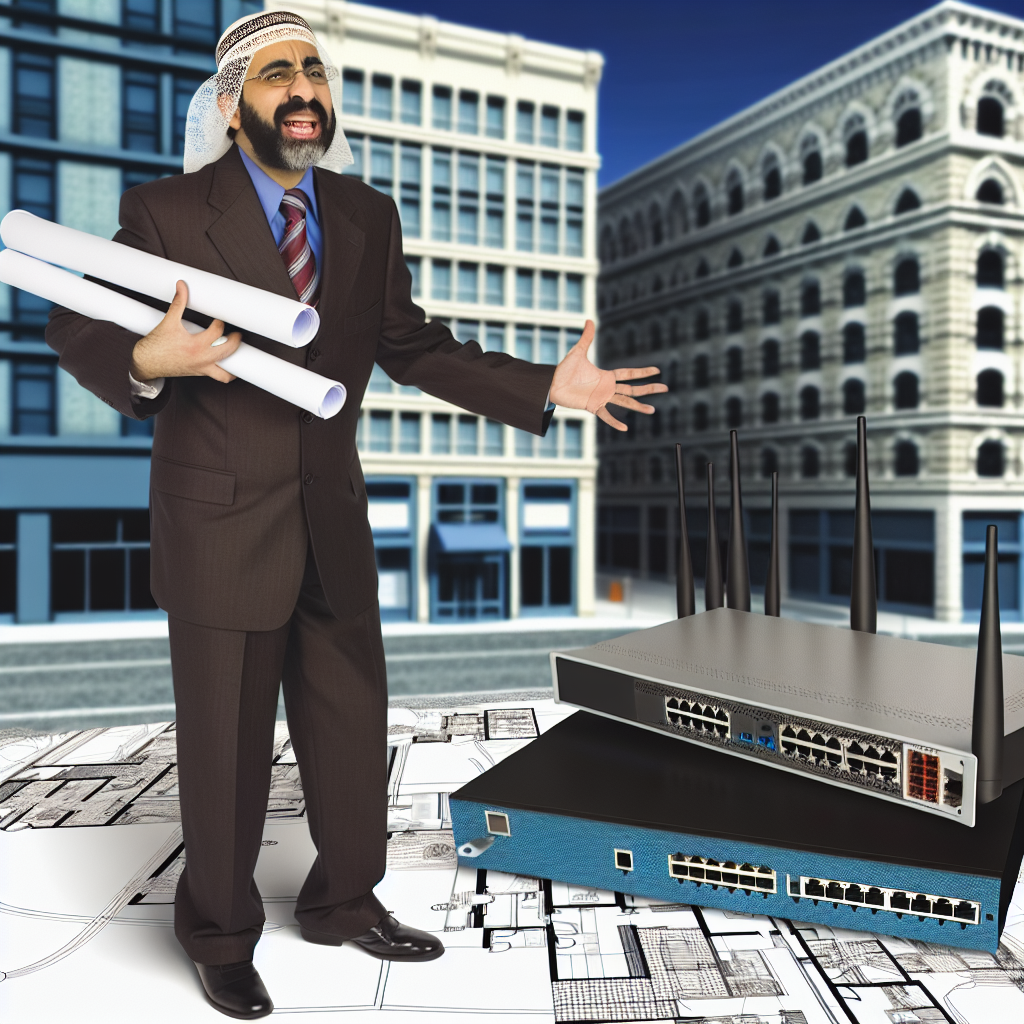Introduction:
Networking equipment plays a crucial role in the daily operations of architects.
It enables seamless communication and collaboration.
Choosing the right networking equipment can significantly enhance efficiency and productivity for architects.
Understanding the Needs of Architects:
Architects require networking equipment that can handle complex design software.
Bandwidth is crucial for transferring large files and collaborating with team members.
Reliability is essential to ensure constant access to project files and resources.
Security is a top priority to protect sensitive client data and intellectual property.
Scalability is important as architectural firms grow and need to expand their network capabilities.
Wireless Networking Recommendations:
When it comes to choosing networking equipment for architects, having a reliable wireless network is crucial for staying connected and productive.
- High-Quality Routers: Investing in a router from a reputable brand such as Cisco, Netgear, or TP-Link can ensure a stable and fast connection for architects.
- Access Points: Setting up multiple access points in your workspace can help eliminate dead zones and provide seamless coverage throughout the office.
Importance of a Strong Wireless Network:
Architects often need to move around their workspace, collaborating with team members or presenting designs to clients.
A strong wireless network is essential for:
- Accessing files and resources quickly without interruptions or delays.
- Using cloud-based applications and software for real-time collaboration.
- Connecting multiple devices such as laptops, tablets, and smartphones simultaneously.
- Ensuring smooth video conferencing and virtual meetings with clients and colleagues.
By following these recommendations and prioritizing a strong wireless network, architects can enhance their productivity and efficiency in a fast-paced industry where connectivity is key.
Learn More: IT Change Manager: The Importance of Continuous Learning
Network Switches and Hubs
Architects rely heavily on their network infrastructure to collaborate effectively with team members.
They access large design files and communicate with clients.
For this reason, having reliable and fast switches in an architect’s office is crucial.
Explanation of the need for reliable and fast switches in an architect’s office
- Architects work with large design files that require quick transfer speeds.
- Team collaboration depends on seamless and reliable network connections.
- Clients expect efficient communication and quick file sharing.
Recommendations for network switches and hubs that meet the requirements of architects
When selecting network switches and hubs for an architect’s office, it is essential to consider factors such as speed, reliability, scalability, and security.
Here are some recommendations that meet the specific needs of architects:
- Cisco Catalyst 2960-X Series Switches: Known for their reliability and speed, these switches are perfect for architects who need a stable network connection for large file transfers and collaboration.
- NETGEAR ProSAFE JGS524E Smart Managed Plus Switch: This switch offers easy management and configuration options, making it ideal for architects who prioritize simplicity and efficiency in their network setup.
- TP-Link 16-Port Gigabit Ethernet Unmanaged Switch: For smaller architect offices, this unmanaged switch provides fast and reliable connectivity without the need for complex setup or configuration.
These recommendations take into account the specific requirements of architects, ensuring that their network infrastructure can support their workflow efficiently and reliably.
Learn More: Impact of Edge Computing on Cloud Engineering
Transform Your Career Today
Unlock a personalized career strategy that drives real results. Get tailored advice and a roadmap designed just for you.
Start NowNetwork Attached Storage (NAS)
Architects deal with large project files that need secure and accessible storage.
Importance of Secure and Accessible Storage for Architects
- Architects work on design projects that involve huge files and sensitive data.
- Lost or corrupted files can cause delays, cost overruns, and potential legal issues.
- Secure and accessible storage is crucial for protecting project assets and maintaining productivity.
Recommendations for NAS Devices
When it comes to NAS devices, architects should look for options that offer ample storage space and data protection features.
- Synology DiskStation DS920+: This NAS device offers up to 64TB of storage capacity, advanced data protection features such as RAID configurations, and easy file sharing capabilities.
- Qnap TS-253D-4G: With a 4-bay design and support for up to 32GB of RAM, this NAS device provides high-speed data transfer, data encryption, and backup solutions.
- Western Digital My Cloud EX2 Ultra: This NAS device is user-friendly, offers up to 28TB of storage, automatic file backup, and remote access capabilities for architects on the go.
- Asustor AS5202T: Equipped with a dual-core CPU and multimedia playback support, this NAS device provides up to 32TB of storage, snapshot protection, and robust security features.
By choosing a reliable NAS device with ample storage capacity and data protection features, architects can ensure that their project files are safe, accessible, and secure.
Discover More: How DevOps Engineers Handle Incident Management
Firewall and Security Solutions:
Network security is crucial for architects handling sensitive information.
Firewall and security solutions are essential to protect against cyber threats.
Importance of Network Security for Architects:
Architects deal with critical data like designs, blueprints, and client information.
Protecting this data from cyber threats is paramount to maintain confidentiality, integrity, and availability.
A breach in security could lead to severe consequences, including compromised designs, leaked confidential information, and damage to the architect’s reputation.
Therefore, implementing robust firewall and security solutions is vital for architects.
Recommendations for Firewall and Security Solutions:
When selecting firewall and security solutions, architects should consider the following factors:
- Next-Generation Firewalls:
- Endpoint Protection:
- Intrusion Detection and Prevention Systems (IDPS):
- Virtual Private Networks (VPNs):
- Secure Email Gateways:
Next-generation firewalls offer advanced threat detection capabilities, such as intrusion prevention, deep packet inspection, and application awareness.
These features help architects mitigate modern cyber threats effectively.
Endpoint protection solutions safeguard individual devices like computers, laptops, and mobile devices.
These solutions prevent malware, unauthorized access, and data breaches on architect’s devices, ensuring a secure work environment.
IDPS monitor network traffic for malicious activities, alerting architects about potential threats.
By deploying IDPS, architects can proactively identify and mitigate security breaches before they escalate.
VPNs establish secure connections over the internet, encrypting data transmitted between architect’s devices and the network.
This encryption ensures data confidentiality and integrity, making it harder for cybercriminals to intercept sensitive information.
Secure email gateways filter inbound and outbound email traffic, blocking malicious content like phishing emails, malware attachments, and spam.
Transform Your Career Today
Unlock a personalized career strategy that drives real results. Get tailored advice and a roadmap designed just for you.
Start NowImplementing secure email gateways protects architects from email-based threats, enhancing overall network security.
Delve into the Subject: Key Responsibilities of Information Security Analysts

Remote Access Tools:
Architects can benefit from remote access tools to work from anywhere by staying connected to their projects.
Remote access tools allow architects to access their files, software, and data from any location with an internet connection.
Recommendations for VPN Services:
- ExpressVPN: Known for its fast speeds and excellent security features, ExpressVPN is a top choice for architects.
- NordVPN: With a vast global network of servers, NordVPN offers reliable and secure connections for architects.
- CyberGhost: User-friendly interface and strong encryption make CyberGhost a great option for architects needing remote access.
Recommendations for Remote Desktop Software:
- TeamViewer: A popular choice for architects, TeamViewer allows easy access to desktops and collaboration with colleagues.
- AnyDesk: With low latency and high-quality video and audio, AnyDesk is suitable for architects working remotely.
- Chrome Remote Desktop: A free tool by Google, Chrome Remote Desktop offers secure access to your desktop from anywhere.
Utilizing remote access tools such as VPN services and remote desktop software can greatly benefit architects by providing flexibility and security in their workflow.
Benefits of Cloud Networking for Architects:
Cloud networking allows architects to easily scale their network resources up or down based on their needs.
It eliminates the need for large upfront investments in hardware and reduces maintenance costs.
Recommendations for Cloud Networking Services:
- Amazon Web Services (AWS): AWS offers a wide range of networking services that architects can leverage for their projects.
- Microsoft Azure: Azure provides a robust set of networking tools and services tailored for architect needs.
- Google Cloud Platform: GCP offers powerful networking solutions, including VPC and load balancing services.
- Cisco Meraki: Meraki’s cloud-managed networking solutions simplify network management for architects.
- VMware NSX: NSX provides advanced networking and security capabilities for architect environments.
Networking Equipment Recommendations for Architects
When choosing networking equipment for architects, consider the scalability of the system.
Ensure the equipment can handle the data-intensive tasks required in architectural design projects.
Look for switching equipment with high bandwidth capabilities to support large file transfers.
Consider investing in routers with advanced security features to protect sensitive project data.
Opt for wireless access points that provide reliable coverage throughout the office or workspace.
Ethernet cables should be high-quality and durable to ensure stable connections for uninterrupted work.
Power over Ethernet (PoE) switches can simplify the setup by providing power and data over a single cable.
Incorporate network monitoring tools to keep track of performance and identify issues promptly.
Importance of Reliable Networking for Architects
Networking equipment is essential for architects to efficiently collaborate and work on projects.
It is crucial for architects to invest in reliable networking solutions to enhance their work efficiency and productivity.
By using high-quality equipment with advanced security features, architects can ensure the safety and integrity of their design projects.
Networking equipment plays a crucial role in the success of architectural projects and should be chosen wisely.
Additional Resources
1 FAM 270 BUREAU OF DIPLOMATIC TECHNOLOGY (DT)
Transform Your Career Today
Unlock a personalized career strategy that drives real results. Get tailored advice and a roadmap designed just for you.
Start NowGuide to Operational Technology (OT) Security
[E-Books for Sale]
The Big Book of 500 High-Paying Jobs in America: Unlock Your Earning Potential
$19.99 • 500 High-Paying Jobs • 330 pages
Explore 500 high-paying jobs in America and learn how to boost your career, earn more, and achieve success!
See All 500 High-Paying Jobs of this E-Book
1001 Professions Without a Degree: High-Paying American Jobs You Can Start Now
$19.99 • 1001 Professions Without a Degree • 174 pages
Discover 1001 high-paying jobs without a degree! Unlock career tips, skills, and success strategies for just $19.99!




